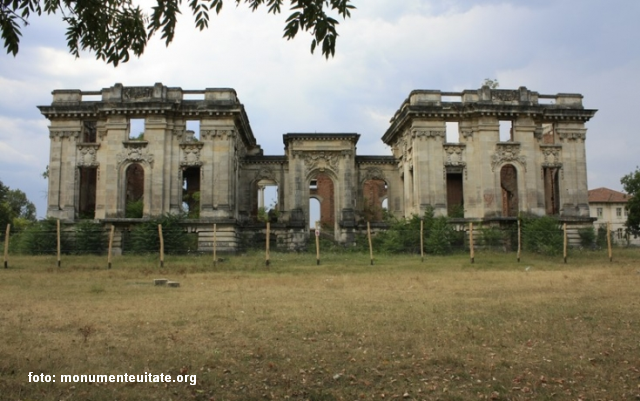Romanian Mansions and Castles
Romania has preserved about one thousand of the local elites' out-of-town residences built between the 17th and 20th centuries

Daniel Onea, 23.03.2017, 12:48
Romania has preserved about one thousand of the local elites’ out-of-town residences built between the 17th
and 20th centuries. Some have been restored, some are degrading,
others are being disputed by inheritors. There are also some mansions built in
town, and some of them have been turned into museums or event centers.
Irina Leca, an art historian, is a funding member and vice president
of the ARCHE association. It is part of a vast on-line platform called Forgotten
Monuments, a great tool for researching and popularizing out-of-town noble
residences. While attempting to avoid talking about the best known castles and
mansions, such as Bran, Peles, Pelisor, or Hunyad Castle, we asked Irina Leca
to give us her top three such monuments:
That is quite a challenge. I did try, however, to look at
the historical regions and pick a representative monument, a witness to history
and major landmark. I would like to single out four or five of them. First of
all, closer to Bucharest we have the mansion in Floresti, near Ploiesti. It was
built by the tycoon Cantacuzino, based on blueprints by Ion Berindei. It is a
beautiful example of early 20th century architecture, and is a
picturesque and vibrant place, though it has been left in ruins. The present
owners are trying to revitalize it, holding there various cultural events, the
most important being the Kapatia Horse Trials horse race, held in September.
Speaking of the province of Moldavia, Irina Leca singled out the
Cuza mansion in Ruginoasa:
This is another example of beautiful Neogothic
architecture, in a superb tree park, a recently restored mansion that houses
the Cuza Museum. Here visitors can find out more about the history of the
Romanian ruler, and especially about Elena Cuza. Going to Transylvania now, we
stop 30 km away from Sighisoara, where we find the Cris mansion. Its history
goes back to the 15th century, according to archeologists; it is a
superb example of Renaissance architecture. It is one of the most authentic and
picturesque places in Transylvania. Even though it is not known to the public
at large, it has been open to tourists for a very long time, and is now in full
process of restoration. It is managed by a foundation that offers guided tours
of the mansion, but also of the Saxon village around it. It is an original out
of town residence that belonged to a Hungarian noble family, but in an area
that was mostly Saxon. Then, further northwest, we find the so-called Peles of
Transylvania, the Karoly mansion in Carei. It has been recently restored with
European funds, and was opened to
tourists a few years ago, in 2013. It was turned into a very interesting
museum, presenting the history of the Karoly family, but also provides a perspective
on these glamorous out of town noble residences of the grand elites of the
Austro-Hungarian Empire.
Art historian Irina Leca told us that
Romania is very competitive in terms of attracting foreign tourists. There are
a few dozen castles and mansions that are particularly attractive:
The list is quite long, and a circuit of these castles,
which are historic monuments, would be feasible and very attractive to the
foreign public. Also, it is very interesting that, just as the French have the
Loire Valley, we also have two rivers that have on their left and right a
collier of castles. On the Mures Valley, from Toplita to the border, there are
dozens of mansions, some of which can be visited and are beautiful, though
others are in a not so good a state. Over the Carpathians there lies the Trotus
Valley. In Darmanesti, Doftana and Comanesti, there are noble mansions which
are quite picturesque and interesting.
Sebastian Marcoci is the manager of the Sturdza Mansion in
Miclauseni, a 600 year old architectural jewel in eastern Romania, with a rich
history. Here is what he told us:
We are talking about the Sturdza family, a very rich
family from Moldavia, with a beautiful story. George Sturdza and Maria Ghica
built a castle here in the Neogothic style on the structure of the old mansion.
It is a special thing in our area. The construction lasted around 24 years. Its
interior is painted in the Art Nouveau style. Maria Ghica was born in Istanbul.
She learned to paint miniatures there. That is also where she leaned English,
and in 1869 she married George Sturdza. After the wedding, the two took a trip
through western countries, Germany, France, and Austria. Upon their return,
they decided to turn their mansion into the
Miclauseni castle.
The Sturdza domain has three essential components: a 30 ha tree
park, the monastery, and the mansion, standing for the spiritual, the cultural,
and the natural components. Sebastian Marcoci:
The castle can be visited every weekend, between noon and
6 PM. There are events throughout the year, but each year, in early September,
we organize an event which is particularly dear to our hearts. It is a festival
called ‘Trip to 1900’. We go back in time, creating a period atmosphere in the
mansion and around it. It usually takes place on the first or second weekend of
September. We got the idea from tourists, who wanted to dress up and relive the
turn of the century period. We thought about that possibility and we can now
offer them costumes to rent, and the food served reflects the gastronomy of 1900.
We have vintage cars, horse drawn carriages, and we organize thematic
workshops. We also have shows with period music, written by Anton Pann, or
music recorded between the wars.
Romania also plays host to an International Festival of Castles,
which in 2017 reaches its third edition. The festival takes place between May 27 and 28 at Corvinus Castle in
Hunedoara.
(Translated by Calin Cotoiu)






























